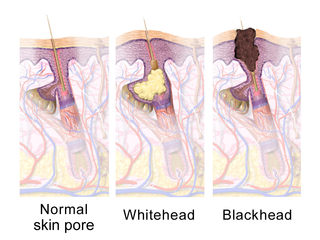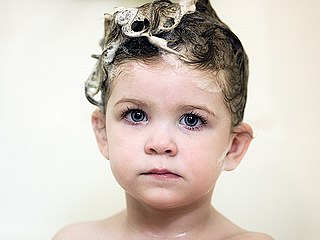
Cosmetics are composed of mixtures of chemical compounds derived from either natural sources or synthetically created ones. Cosmetics have various purposes. Those designed for personal care and skin care can be used to cleanse or protect the body and skin. Cosmetics designed to enhance or alter one's appearance (makeup) can be used to conceal blemishes, enhance one's natural features, add color to a person's face, or change the appearance of the face entirely to resemble a different person, creature or object. Cosmetics can also be designed to add fragrance to the body.

A facial is a family of skin care treatments for the face, including steam, exfoliation, extraction, creams, lotions, facial masks, peels, and massage. They are normally performed in beauty salons, but are also a common spa treatment. They are used for general skin health as well as for specific skin conditions. Types of facials include European facial, LED light therapy facials, hydrafacials and mini-facials.

Microfibre is synthetic fibre finer than one denier or decitex/thread, having a diameter of less than ten micrometers.

A moisturizer, or emollient, is a cosmetic preparation used for protecting, moisturizing, and lubricating the skin. These functions are normally performed by sebum produced by healthy skin. The word "emollient" is derived from the Latin verb mollire, to soften.

A comedo is a clogged hair follicle (pore) in the skin. Keratin combines with oil to block the follicle. A comedo can be open (blackhead) or closed by skin (whitehead) and occur with or without acne. The word "comedo" comes from the Latin comedere, meaning "to eat up", and was historically used to describe parasitic worms; in modern medical terminology, it is used to suggest the worm-like appearance of the expressed material.

Hair care or haircare is an overall term for hygiene and cosmetology involving the hair which grows from the human scalp, and to a lesser extent facial, pubic and other body hair. Hair care routines differ according to an individual's culture and the physical characteristics of one's hair. Hair may be colored, trimmed, shaved, plucked or otherwise removed with treatments such as waxing, sugaring and threading. Hair care services are offered in salons, barbershops and day spas, and products are available commercially for home use. Laser hair removal and electrolysis are also available, though these are provided by licensed professionals in medical offices or speciality spas.

In cosmetics, skin toner or simply toner refers to a lotion, tonic or wash designed to cleanse the skin and shrink the appearance of pores, usually used on the face. It also moisturizes, protects and refreshes the skin. Toners can be applied to the skin in different ways:

In cosmetology, exfoliation is the removal of the surface skin cells and built-up dirt from the skin's surface. The term comes from the Latin word exfoliare. This is a regular practice within the cosmetic industry, both for its outcome of promoting skin regeneration as well as providing a deep cleanse of the skin barrier. Being used in facials, this process can be achieved by mechanical or chemical means, such as microdermabrasion or chemical peels. Exfoliants are advertised as treatments that enhance beauty and promote a youthful and healthy appearance.

Lotion is a low-viscosity topical preparation intended for application to the skin. By contrast, creams and gels have higher viscosity, typically due to lower water content. Lotions are applied to external skin with bare hands, a brush, a clean cloth, or cotton wool.

Skin care or skincare is a range of practices that support skin integrity, enhance its appearance, and relieve skin conditions. They can include nutrition, avoidance of excessive sun exposure, and appropriate use of emollients. Practices that enhance appearance include the use of cosmetics, botulinum, exfoliation, fillers, laser resurfacing, microdermabrasion, peels, retinol therapy, and ultrasonic skin treatment. Skin care is a routine daily procedure in many settings, such as skin that is either too dry or too moist, and prevention of dermatitis and prevention of skin injuries.

Shower gel is a specialized liquid product used for cleaning the body during showers. Not to be confused with liquid soaps, shower gels, in fact, do not contain saponified oil. Instead, it uses synthetic detergents derived from either petroleum or plant sources.

A facial mask is a creamy or thick pasted mask applied to the face for cleansing or skin-smoothing purposes. Facial masks often contain minerals, vitamins, and fruit extracts, such as cactus and cucumber. A sheet mask is a piece of paper, cellulose or fabric used to apply a facial mask.
Personal care products are consumer products which are applied on various external parts of the body such as skin, hair, nails, lips, external genital and anal areas, as well as teeth and mucous membrane of the oral cavity, in order to make them clean, protect them from harmful germs and keep them in good condition. They promote personal hygiene and overall health, well-being and appearance of those body parts. Toiletries form a narrower category of personal care products which are used for basic hygiene and cleanliness as a part of a daily routine. Cosmetic products, in contrast, are used for personal grooming and beautification. Pharmaceutical products are not considered personal care products.

Cleaning agents or hard-surface cleaners are substances used to remove dirt, including dust, stains, foul odors, and clutter on surfaces. Purposes of cleaning agents include health, beauty, removing offensive odor, and avoiding the spread of dirt and contaminants to oneself and others. Some cleaning agents can kill bacteria and clean at the same time. Others, called degreasers, contain organic solvents to help dissolve oils and fats.
The oil cleansing method, often abbreviated as OCM, is a system for cleaning the human body. It is sometimes used for treating acne. Sometimes, oils can be mixed; one example is 50% extra virgin olive oil and 50% castor oil. This mixture can be optimized based on skin type and personal preference.

Shampoo is a hair care product, typically in the form of a viscous liquid, that is used for cleaning hair. Less commonly, shampoo is available in solid bar format. Shampoo is used by applying it to wet hair, massaging the product into the scalp, and then rinsing it out. Some users may follow a shampooing with the use of hair conditioner.
Acne mechanica is an acneiform eruption that has been observed after repetitive physical trauma to the skin such as rubbing, occurring from clothing or sports equipment. In addition to those mechanisms, the skin not getting enough exposure to air also contributes to the formation of acne mechanica. It is often mistaken as a rash that forms on sweaty skin that is constantly being rubbed, but in reality, it is a breakout of acne mechanica. The term "acne" itself describes the occurrence in which hair follicles in the skin get clogged by oil, dead skin cells, dirt and bacteria, or cosmetic products and create a pimple. Pimples can vary in type, size, and shape, but the sole basis of them occurring is the same - the oil gland in the pore becomes clogged and sometimes infected, which creates pus in order to fight the infection and subsequently causes the development of swollen, red lesions on the skin.

A pimple or zit is a kind of comedo that results from excess sebum and dead skin cells getting trapped in the pores of the skin. In its aggravated state, it may evolve into a pustule or papule. Pimples can be treated by acne medications, antibiotics, and anti-inflammatories prescribed by a physician, or various over the counter remedies purchased at a pharmacy.

Dry shampoo otherwise known as hybrid shampoo is a type of shampoo which reduces hair greasiness without the need for water. It is in powder form and is typically administered from an aerosol can. Dry shampoo is often based on corn starch or rice starch. In addition to cleansing hair, it can also be used as a tool for hair-styling as it can create volume, help tease hair, keep bobby pins in place, and be used in place of mousse in wet hair. Dry shampoo proponents attest that daily wash-and-rinse with detergent shampoo can strip away natural oils from hair. However, others attest that spraying dry shampoo every day will lead to a build-up of product that can dull hair color and irritate the scalp, arguing that the scalp needs regular cleansing and exfoliating to get rid of bacteria, remove dead skin cells, and stay healthy.
The Baumann Skin Types system is a skin-type classification system defining 16 skin personalities. This skin-typing system was developed in 2004 by University of Miami dermatology professor Dr. Leslie Baumann, to subdivide research participants into specific phenotypes for research on skin types. She assigns binary values to four characteristics, so she defines sixteen "skin personalities", or "skin types". These have been used in genetic research aimed at identifying the genes that contribute to skin characteristics such as dryness, oiliness, aging, pigmentation, and sensitivity. The survey-based typing system combines these individual skin attributes into 16 personalities that allow researchers to improve their ability to identify various skin phenotypes and use that knowledge for patient selection for clinical research trials to recommend proper skincare ingredients and products, and to build skincare routines. The classification system has been adopted by estheticians, dermatologists, consumers, and retailers to match cosmeceutical ingredients and skin care products to specific skin types. The type assigned is determined by a self-completed questionnaire, marketed as the "Baumann Skin Type Indicator" (BSTI).















